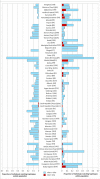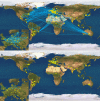Toward male individualization with rapidly mutating y-chromosomal short tandem repeats
- PMID: 24917567
- PMCID: PMC4145662
- DOI: 10.1002/humu.22599
Toward male individualization with rapidly mutating y-chromosomal short tandem repeats
Abstract
Relevant for various areas of human genetics, Y-chromosomal short tandem repeats (Y-STRs) are commonly used for testing close paternal relationships among individuals and populations, and for male lineage identification. However, even the widely used 17-loci Yfiler set cannot resolve individuals and populations completely. Here, 52 centers generated quality-controlled data of 13 rapidly mutating (RM) Y-STRs in 14,644 related and unrelated males from 111 worldwide populations. Strikingly, >99% of the 12,272 unrelated males were completely individualized. Haplotype diversity was extremely high (global: 0.9999985, regional: 0.99836-0.9999988). Haplotype sharing between populations was almost absent except for six (0.05%) of the 12,156 haplotypes. Haplotype sharing within populations was generally rare (0.8% nonunique haplotypes), significantly lower in urban (0.9%) than rural (2.1%) and highest in endogamous groups (14.3%). Analysis of molecular variance revealed 99.98% of variation within populations, 0.018% among populations within groups, and 0.002% among groups. Of the 2,372 newly and 156 previously typed male relative pairs, 29% were differentiated including 27% of the 2,378 father-son pairs. Relative to Yfiler, haplotype diversity was increased in 86% of the populations tested and overall male relative differentiation was raised by 23.5%. Our study demonstrates the value of RM Y-STRs in identifying and separating unrelated and related males and provides a reference database.
Keywords: RM Y-STRs; Y-STRs; Y-chromosome; forensic; haplotypes; paternal lineage.
© 2014 The Authors. **Human Mutation published by Wiley Periodicals, Inc.
Figures





Comment in
-
What identity crisis? Rapidly mutating Y-STRs facilitate differentiation of males.Hum Mutat. 2014 Aug;35(8):v. doi: 10.1002/humu.22412. Hum Mutat. 2014. PMID: 25043980 No abstract available.
References
-
- Ballantyne KN, Keerl V, Wollstein A, Choi Y, Zuniga SB, Ralf A, Vermeulen M, de Knijff P, Kayser M. A new future of forensic Y-chromosome analysis: rapidly mutating YSTRs for differentiating male relatives and paternal lineages. Forensic Sci Int Genet. 2012;6:208–218. - PubMed
-
- Brenner CH. Fundamental problem of forensic mathematics—the evidential value of a rare haplotype. Forensic Sci Int Genet. 2010;4:281–291. - PubMed
Publication types
MeSH terms
Grants and funding
LinkOut - more resources
Full Text Sources
Other Literature Sources

